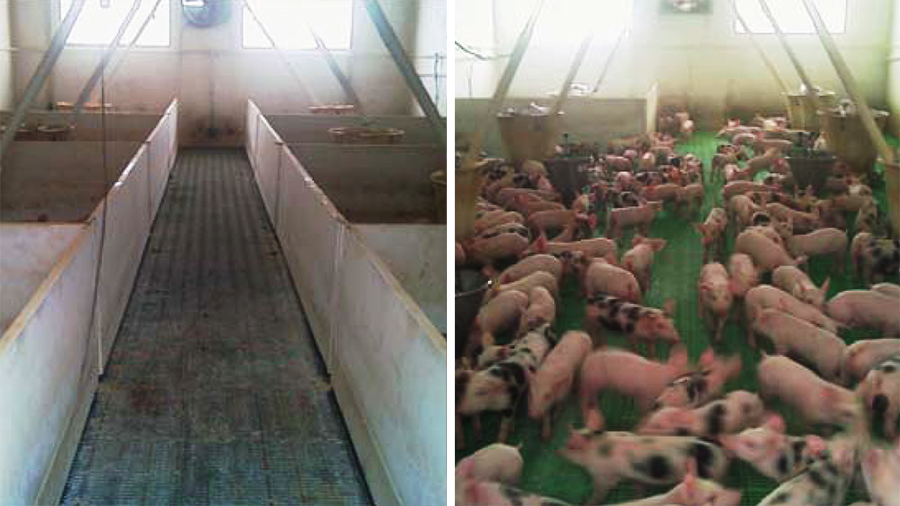Evolution of production
From the early 2000s to the present, husbandry conditions for pigs have clearly undergone substantial changes in various aspects.

Genetic advances in the so-called hyper-prolific sows have led to average farrowings of more than 14 live piglets. Thus we are confronted with a greater number of animals at weaning, large weight differences between them and, in many cases, they are housed in pens that have been designed for the type of production farmers could expect more than 10 years ago.
As Table 1 shows, the increase in prolificacy and average number of weaned piglets has sped up in recent years.
Table 1. Number of born and weaned piglets per litter in various periods. Source: BDporc.
| Increase in: | 2010-2015 (1st S) | 2005-2010 | 2000-2005 |
| Total born | +1.36 | +0.89 | +0.54 |
| Average of weaned piglets | +1.04 | +0.75 | +0.36 |
There is one important consideration to be taken into account: not only the same floor surface that was available when prolificacy was lower is currently available for each piglet, but also the feeder surface. This will obviously lead to added problems such as the amount of feeder surface per piglet, and a greater difficulty for all the weaned piglets in the group to access the aforementioned feeder.
In addition to all this, this production increase has taken place in a very consistent context of low post-weaning mortality (Figure 1), so we may well be talking about a reduction of space per piglet close to 10%.


Figure 1. Evolution of productivity per sow and post-weaning mortality. Source: SIP Consultors.
Space reduction, which affects density and accessibility to the feeder, is a structural constraint on farms that slows down the development and growth of piglets, impairing the growth potential of the feed formula.
Another immediate consequence of this overcrowding is weight dispersion and unevenness amongst the animals at the end of this phase, which results in loss of profitability in the next fattening phase, with longer times in the unit, lower number of places for rotation at the end of the year, penalties at the slaughterhouse, etc.

Space per animal at weaning. Open housing
As previously mentioned, the actual surface available per weaned piglet at weaning is smaller, leading to an increase of hierarchy problems. In addition, the lying, feeding and dunging areas overlap each other and become dirty, leading to a reduction in comfort, especially for the smallest animals.
If there are no clearly defined lying/feeding areas, the strongest piglets will rest near the feeders, preventing the smaller ones from easily accessing them. Subsequent reorganization of these piglets that are left behind is made difficult by the increase in hierarchy problems, which are sometimes worse than they were to start with.
Studies suggest (Donadeu, 2011) that the productive performance of piglets in large spaces is better if we prioritize the space per piglet above feeder space per piglet.

Photos 1 & 2 Available space per piglet is bigger in open housing than in conventional rooms. Source: Andrés Donadeu, 2011.
Open housing is a possible solution, i.e., keeping the same number of feeders and drinkers of a conventional room with several pens, but eliminating the partitions, leaving one only group in the same space. In our experience, the average increment of space for the piglets was 12%, with a length of stay of 6 weeks (20 kg LW).
This increase takes us closer to the welfare legislation —that requires a space of 0.20 m2/animal—, than the standard conditions (Table 2.)
Table 2. Variation in density and access to the feeder in open housing vs. conventional rooms. Source: Andrés Donadeu, 2011
| Density (m2/piglet) | Feeder (cm/piglet) | |||
| Farms | Room with pens | Open housing | Room with pens | Open housing |
| A | 0.166 | 0.189 | 3.30 | 3.33 |
| B | 0.227 | 0.258 | 6.18 | 6.17 |
| C | 0.201 | 0.221 | 5.25 | 5.17 |
| D | 0.186 | 0.204 | 4.13 | 4.11 |
| Average | 0.195 | 0.218 | 4.715 | 4.695 |
The increase of space per piglet helps reduce fights and subsequent injuries in big batches (Table 3.) Measurements were made between the first and the second day after arrival.
Table 3. Proportion of animals injured in open housing vs. conventional rooms. Source: Andrés Donadeu, 2011.
| % animals injured | % animals injured | |||||
| Farms |
Room with pens |
Open housing | Injury degree | Room with pens | Open housing | |
| A | 76.1 | 29.8 |  |
I | 21.4 | 13.1 |
| B | 83.2 | 14.8 |  |
II | 19.2 | 3.7 |
| C | 69.3 | 20.5 |  |
III | 29.7 | 2.2 |
| D | 78.9 | 18.2 |  |
IV | 1.1 | 0.8 |
| E | 58.4 | 12.4 | Total | 71.4 | 19.8 | |
| F | 62.6 | 23.1 | ||||
| Average | 71.4 | 19.8 | ||||
Why does this happen? We could name several factors:
- Identification amongst individuals: very difficult in large groups.
- Large areas that allow a quick escape.
- Access to feeders and drinkers is always possible.
- Feeding, lying and dunging areas clearly defined: improved comfort.
In each open room there are one or two pens for immature piglets that allow us to better adjust the feed, as well as specific treatments for these animals.
It is interesting to note that, in general, ventilation improves, because the piglets are able to walk further away from the dunging areas and self-regulate their own comfort.
Problems of regroupment in the fattening pens are generally less common with these types of groups that they are with piglets coming from smaller groups.


